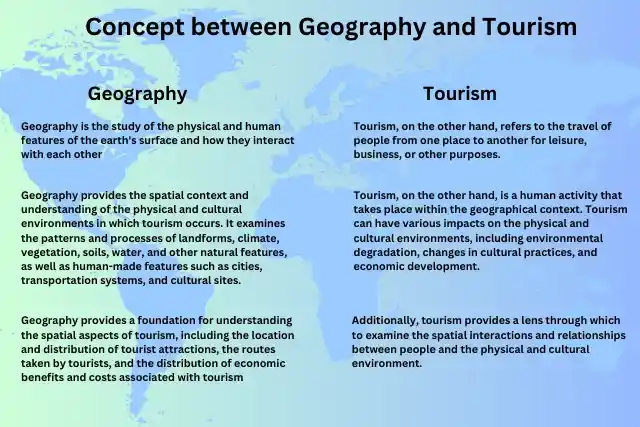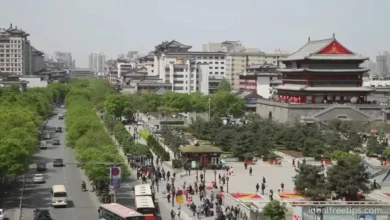
What is Tourism Geography? Concept between Tourism and Geography
Tourism is a multifaceted and dynamic industry that involves the movement of people from one place to another for various purposes, including leisure, business, and education. It is a significant contributor to global economic growth, employment, and foreign exchange earnings, with millions of people traveling to different parts of the world every year. However, the impacts of tourism on the physical and cultural environments in which it occurs are complex and multifaceted.
This is where tourism geography comes in as a vital field of study that examines the relationships and interactions between tourism and the natural and human-made environments in which it occurs. By understanding the spatial patterns, processes, and impacts of tourism activities, tourism geography can inform the planning, management, and sustainability of tourism destinations, as well as contribute to cultural preservation, economic development, and environmental conservation.
In this blog post, we will explore what tourism geography is, its key roles and concepts, and its significance in the tourism industry.
What is Tourism Geography?
Tourism geography is a branch of geography that specifically examines the relationships and interactions between tourism and the natural and human-made environments in which it occurs. It is concerned with understanding the spatial patterns, processes, and impacts of tourism activities on the physical and cultural landscapes at various scales. It involves the study of the spatial patterns, processes, and impacts of tourism at different scales, including local, regional, national, and international.
Tourism geography examines how the natural and built environments, such as landscapes, cities, and heritage sites, are used for tourism purposes and how tourism influences these environments. It also analyzes the economic, social, and environmental impacts of tourism, including the effects on local communities, the natural environment, and cultural heritage.
What is the role of Tourism Geography?
Tourism geography is an essential field of study that provides valuable insights into the complex relationships between tourism and the physical and cultural environments in which it occurs.
Tourism geography plays a crucial role in understanding the complex interactions between tourism and the physical and cultural environments. Some of the key roles of tourism geography include
- Planning and development
- Management and sustainability
- Marketing promotion
- Research and education
- Understanding tourist behavior
- Cultural preservation
- Economic development
- Environmental conservation
- Public policy and governance
Planning and development
Tourism geography can inform the planning and development of tourism destinations by identifying the strengths and weaknesses of the natural and cultural resources in a particular area. It can also help to assess the potential impacts of tourism development and guide decision-making on the most appropriate tourism activities for the area.
Management and sustainability
Tourism geography can help to manage and sustain tourism destinations by providing insights into the carrying capacity of an area, the impacts of tourism on the environment and local communities, and the development of sustainable tourism practices that minimize negative impacts.
Marketing and promotion
Tourism geography can assist in the marketing and promotion of tourism destinations by identifying the unique selling points of an area, such as its cultural heritage or natural landscapes. It can also help to develop targeted marketing campaigns that appeal to specific types of tourists based on their interests and preferences.
Research and education
Tourism geography plays a crucial role in conducting research and education on various aspects of tourism, such as tourist behavior, impacts of tourism, and tourism planning and management. This research can contribute to the development of sustainable tourism practices and policies and inform the education and training of future tourism professionals.
Understanding tourist behavior
Tourism geography can help to understand the motivations, preferences, and behaviors of tourists by analyzing their travel patterns, preferences for activities, and cultural interactions. This understanding can help to tailor tourism experiences to the needs and desires of different types of tourists.
Cultural preservation
Tourism geography can play a role in cultural preservation by identifying and protecting cultural heritage sites and promoting sustainable tourism practices that respect local cultures and traditions.
Economic development
Tourism geography can contribute to the economic development of a region by identifying opportunities for tourism-related businesses, promoting entrepreneurship and innovation, and analyzing the economic impacts of tourism.
Environmental conservation
Tourism geography can help to promote environmental conservation by identifying areas of ecological significance, developing sustainable tourism practices that minimize negative impacts on the environment, and promoting responsible tourism behaviors among tourists.
Public policy and governance
Tourism geography can inform public policy and governance by providing insights into the social, economic, and environmental impacts of tourism and guiding the development of policies and regulations that promote sustainable and responsible tourism practices.
Concept between geography and tourism
|
Geography |
Tourism |
| Geography is the study of the physical and human features of the earth’s surface and how they interact with each other | Tourism, on the other hand, refers to the travel of people from one place to another for leisure, business, or other purposes. |
| Geography provides the spatial context and understanding of the physical and cultural environments in which tourism occurs. It examines the patterns and processes of landforms, climate, vegetation, soils, water, and other natural features, as well as human-made features such as cities, transportation systems, and cultural sites. | Tourism, on the other hand, is a human activity that takes place within the geographical context. Tourism can have various impacts on the physical and cultural environments, including environmental degradation, changes in cultural practices, and economic development. |
| Geography provides a foundation for understanding the spatial aspects of tourism, including the location and distribution of tourist attractions, the routes taken by tourists, and the distribution of economic benefits and costs associated with tourism | Additionally, tourism provides a lens through which to examine the spatial interactions and relationships between people and the physical and cultural environment. |
Conclusion
In conclusion, tourism geography is a vital field of study that examines the relationships and interactions between tourism and the natural and human-made environments in which it occurs. Through its various roles and concepts, it provides valuable insights into the complex impacts of tourism on the physical and cultural landscapes, informing the planning, management, and sustainability of tourism destinations. By understanding the spatial patterns, processes, and impacts of tourism activities, tourism geography contributes to cultural preservation, economic development, and environmental conservation in the tourism industry.
You may like:




